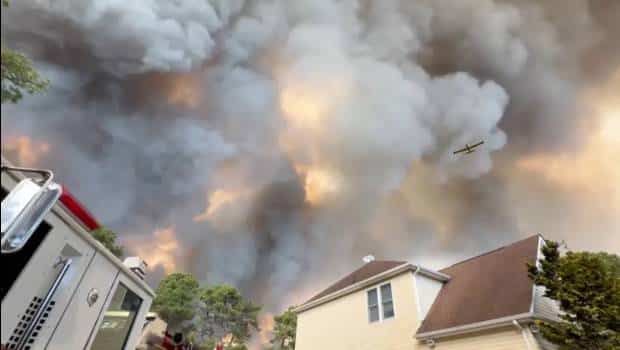A massive wildfire, dubbed the Jones Road Wildfire, erupted in the Greenwood Forest Wildlife Management Area in Barnegat Township, Ocean County, New Jersey, on April 22, 2025, scorching over 8,500 acres and prompting the evacuation of approximately 3,000 residents. The blaze, which began around 10 a.m., rapidly spread to Ocean and Lacey Townships, threatening 1,320 structures, including homes and businesses. Thick smoke and intense flames led to the closure of sections of the Garden State Parkway, one of the state’s busiest highways, and several local roads, such as Route 9 and Wells Mills Road. Despite the severity, no injuries have been reported, and authorities confirmed that evacuation orders were lifted on the morning of April 23, allowing residents to return home. Jersey Central Power & Light (JCP&L) cut power to about 25,000 customers to ensure the safety of firefighting crews, leaving thousands without electricity. The fire, which reached only 10% containment by Tuesday night, comes amid a severe drought in the region, exacerbated by winds up to 25 mph, complicating containment efforts.
The fire’s rapid spread created chaotic scenes in Ocean County, with residents reporting traffic gridlock as they fled areas under mandatory evacuation orders. In Lacey Township, neighborhoods like Pheasant Run and areas near Beach Boulevard were evacuated, while Barnegat Township issued voluntary evacuation orders. Shelters were opened at schools, including Southern Regional High School in Manahawkin and Manchester Township High School, to accommodate displaced residents. The fire’s cause remains under investigation, and authorities plan to provide updates at a press conference scheduled for the morning of April 23 at Coyle Field Air Attack Base.
The fire’s impact was worsened by adverse weather conditions, with New Jersey grappling with a prolonged drought that left vegetation highly flammable. The New Jersey Forest Fire Service deployed significant resources, including tanker trucks, bulldozers, helicopters, and a tanker plane capable of dropping 600 gallons of water at a time. Despite these efforts, the fire continues to challenge crews, with only 10% containment achieved so far. Lieutenant Governor Tahesha Way declared a state of emergency in Ocean County, highlighting the situation’s severity and the need for a coordinated response.
- Fire size: 8,500 acres burned, equivalent to 34 square kilometers.
- Structures threatened: 1,320, including homes and businesses.
- Evacuations: Approximately 3,000 residents evacuated in Ocean and Lacey Townships.
- Power outages: 25,000 customers affected by JCP&L’s service interruption.
Context of wildfires in the Pine Barrens
The Pine Barrens, where the fire is occurring, is a 1.1-million-acre protected reserve located between Philadelphia and the Atlantic coast. Known for its dense vegetation and sandy soils, the area is prone to wildfires, especially during drought periods. In recent years, the New Jersey Forest Fire Service recorded an average of 7,000 acres burned annually, but the Jones Road Wildfire has already surpassed this average in a single event. The drought affecting the state since the fall of 2024, with precipitation well below average, created ideal conditions for fire spread, worsened by strong winds that rapidly carry embers.
This is the second major fire in the region in less than a week. On the previous Friday, April 18, the Danny’s Wildfire burned 1,300 acres in the Peaslee Wildlife Management Area in Vineland, Cumberland County. Although that fire was contained more quickly, the recurrence of events in such a short time raises concerns about New Jersey’s vulnerability to wildfires amid climate change. Lieutenant Governor Tahesha Way noted that the current drought is one of the worst in decades, requiring stringent preventive measures.
Immediate impacts in Ocean County
The Jones Road Wildfire turned residential areas of Ocean and Lacey Townships into scenes of tension. Residents described skies shrouded in thick smoke and the constant sound of sirens and helicopters. Debi Schaffer, a Waretown resident, reported being stuck in traffic while evacuating with her two dogs, while her husband chose to stay home to protect their 22 chickens. She described the situation around her home as “like a war zone,” with dense smoke and incessant emergency operations.
Several businesses in an industrial park in Lacey Township were damaged, some completely destroyed by the flames. However, homes appear to have sustained minimal damage so far, according to Ocean County Deputy Sheriff Jon Lombardi. The fire’s proximity to the Out of Sight Alpaca Farm raised concerns, but the farm confirmed on Facebook that its property was not threatened, and all animals are safe. The decommissioned Oyster Creek nuclear power plant, located a few miles away, was also unaffected, with nuclear fuel stored safely.
Power outages, affecting about 25,000 customers, were implemented by JCP&L at the request of the New Jersey Forest Fire Service to protect firefighters working near high-voltage lines. The company stated that power restoration depends on the safety of firefighting operations, with some areas being reconnected to neighboring lines where possible. The lack of electricity, combined with road closures, hindered mobility and communication in the region.
Authorities’ response and containment efforts
The response to the fire involved a massive mobilization of resources. The New Jersey Forest Fire Service, alongside local and state firefighters, employed tactics such as controlled burns, digging containment lines, and aerial attacks. A reconnaissance helicopter and another capable of dropping 300 gallons of water, along with a tanker plane carrying 600 gallons, were used to combat the flames. Bulldozers cleared paths to limit the fire’s spread, while ground crews protected threatened structures.
Lacey Township Mayor Peter Curatolo described the event as “historic,” noting that no fire of this magnitude is recalled in recent memory. He urged residents to avoid roads to facilitate emergency operations. Barnegat police warned that dense smoke reduced visibility, advising drivers to exercise caution. A press conference planned for Tuesday evening was canceled due to the rapidly evolving situation, but authorities promised detailed updates on Wednesday morning.
- Mobilized resources: Helicopters, tanker plane, bulldozers, and ground crews.
- Road closures: Garden State Parkway (between exits 63 and 80), Route 9, Wells Mills Road, Bryant Road, and Jones Road.
- Available shelters: Southern Regional High School and Manchester Township High School, with space for pets.
Community impacts and personal stories
The mass evacuation left emotional scars on residents. Many expressed fear of losing their homes and the challenge of leaving belongings behind. Carmine, a Waretown resident, was photographed with his dog Amber outside the shelter at Southern Regional High School, awaiting news about his home’s safety. Others, like Debi Schaffer, faced practical dilemmas, such as deciding which animals to take during the escape. Community solidarity was evident, with churches and local schools opening their doors to provide shelter and support.
The fire’s smoke, visible from miles away, affected air quality in Ocean County, prompting a public health alert. Residents were advised to keep windows closed and avoid outdoor activities. Prolonged power outages also impacted essential services, such as supermarkets and gas stations, forcing residents to seek alternatives in neighboring towns.
The fire comes amid growing concern about drought in New Jersey. Governor Phil Murphy, in a recent statement about another fire, emphasized that extreme weather conditions, driven by climate change, demand collective action to reduce risks. The lack of significant rainfall since September 2024 has heightened forest vulnerability, making events like the Jones Road Wildfire more frequent and intense.
Climate context and future risks
The prolonged drought in New Jersey, classified as “severe” by the National Weather Service, is a critical factor in the increased frequency and severity of wildfires. While early spring rains provided temporary relief, the absence of significant precipitation in recent months left vegetation dry and prone to ignition. Winds of 15 to 25 mph on the afternoon of April 22 accelerated the fire’s spread, complicating containment efforts.
Experts warn that climate change is intensifying wildfire risks in areas previously considered less prone, such as the northeastern United States. A report from New Jersey’s Department of Environmental Protection indicates that the state could face a 20% increase in wildfire incidents by 2030 if drought conditions persist. The New Jersey Forest Fire Service emphasized the need for preventive measures, such as banning open burns and careful use of cigarettes and matches.
The Jones Road Wildfire also highlights the challenges of protecting urban areas near forests. Many homes in Ocean and Lacey Townships are surrounded by dense vegetation, increasing the risk of damage. Mitigation programs, such as creating safety zones around properties, have been implemented, but the problem’s scale requires significant investment.
Timeline of recent wildfires in New Jersey
New Jersey has faced a series of wildfires in recent months, driven by adverse weather conditions. Below is a timeline of major events:
- November 2024: The Jennings Creek Wildfire burns 2,283 acres on the New Jersey-New York border, with 75% containment on the New Jersey side.
- October 2024: The Microwave Wildfire consumes 77 acres in Rockaway Township, Morris County, with 85% containment.
- April 18, 2025: The Danny’s Wildfire burns 1,300 acres in the Peaslee Wildlife Management Area, Vineland, Cumberland County.
- April 22, 2025: The Jones Road Wildfire devastates 8,500 acres in Greenwood Forest, Ocean County, with 10% containment.
Recovery efforts and outlook
With evacuation orders lifted on the morning of April 23, residents of Ocean and Lacey Townships began returning home, though lingering smoke and power outages continue to affect the region. The New Jersey Forest Fire Service plans to intensify containment efforts, leveraging forecasts of weaker winds in the coming days. Rain expected for Friday night and Saturday may help control the fire, but authorities warn that the underlying drought will keep risks elevated.
Rebuilding the affected areas will be challenging, particularly for businesses damaged in Lacey Township. The state government pledged financial support for those impacted, though details remain undisclosed. The state of emergency declared by Tahesha Way facilitates access to federal resources, which may be crucial for recovery.
The Ocean County community demonstrated resilience amid the crisis, with volunteers and local organizations providing food, clothing, and shelter to evacuees. The Jones Road Wildfire experience underscores the importance of investing in prevention and preparedness, from modernizing infrastructure to raising public awareness about fire safety. As the fire continues to burn, New Jersey faces the challenge of balancing immediate response with long-term strategies to mitigate future disasters.
- Weather forecast: Weaker winds until Friday; rain expected over the weekend.
- Community support: Volunteers provide food and shelter at evacuation centers.
- Persistent risks: Severe drought maintains high likelihood of new fires.

A massive wildfire, dubbed the Jones Road Wildfire, erupted in the Greenwood Forest Wildlife Management Area in Barnegat Township, Ocean County, New Jersey, on April 22, 2025, scorching over 8,500 acres and prompting the evacuation of approximately 3,000 residents. The blaze, which began around 10 a.m., rapidly spread to Ocean and Lacey Townships, threatening 1,320 structures, including homes and businesses. Thick smoke and intense flames led to the closure of sections of the Garden State Parkway, one of the state’s busiest highways, and several local roads, such as Route 9 and Wells Mills Road. Despite the severity, no injuries have been reported, and authorities confirmed that evacuation orders were lifted on the morning of April 23, allowing residents to return home. Jersey Central Power & Light (JCP&L) cut power to about 25,000 customers to ensure the safety of firefighting crews, leaving thousands without electricity. The fire, which reached only 10% containment by Tuesday night, comes amid a severe drought in the region, exacerbated by winds up to 25 mph, complicating containment efforts.
The fire’s rapid spread created chaotic scenes in Ocean County, with residents reporting traffic gridlock as they fled areas under mandatory evacuation orders. In Lacey Township, neighborhoods like Pheasant Run and areas near Beach Boulevard were evacuated, while Barnegat Township issued voluntary evacuation orders. Shelters were opened at schools, including Southern Regional High School in Manahawkin and Manchester Township High School, to accommodate displaced residents. The fire’s cause remains under investigation, and authorities plan to provide updates at a press conference scheduled for the morning of April 23 at Coyle Field Air Attack Base.
The fire’s impact was worsened by adverse weather conditions, with New Jersey grappling with a prolonged drought that left vegetation highly flammable. The New Jersey Forest Fire Service deployed significant resources, including tanker trucks, bulldozers, helicopters, and a tanker plane capable of dropping 600 gallons of water at a time. Despite these efforts, the fire continues to challenge crews, with only 10% containment achieved so far. Lieutenant Governor Tahesha Way declared a state of emergency in Ocean County, highlighting the situation’s severity and the need for a coordinated response.
- Fire size: 8,500 acres burned, equivalent to 34 square kilometers.
- Structures threatened: 1,320, including homes and businesses.
- Evacuations: Approximately 3,000 residents evacuated in Ocean and Lacey Townships.
- Power outages: 25,000 customers affected by JCP&L’s service interruption.
Context of wildfires in the Pine Barrens
The Pine Barrens, where the fire is occurring, is a 1.1-million-acre protected reserve located between Philadelphia and the Atlantic coast. Known for its dense vegetation and sandy soils, the area is prone to wildfires, especially during drought periods. In recent years, the New Jersey Forest Fire Service recorded an average of 7,000 acres burned annually, but the Jones Road Wildfire has already surpassed this average in a single event. The drought affecting the state since the fall of 2024, with precipitation well below average, created ideal conditions for fire spread, worsened by strong winds that rapidly carry embers.
This is the second major fire in the region in less than a week. On the previous Friday, April 18, the Danny’s Wildfire burned 1,300 acres in the Peaslee Wildlife Management Area in Vineland, Cumberland County. Although that fire was contained more quickly, the recurrence of events in such a short time raises concerns about New Jersey’s vulnerability to wildfires amid climate change. Lieutenant Governor Tahesha Way noted that the current drought is one of the worst in decades, requiring stringent preventive measures.
Immediate impacts in Ocean County
The Jones Road Wildfire turned residential areas of Ocean and Lacey Townships into scenes of tension. Residents described skies shrouded in thick smoke and the constant sound of sirens and helicopters. Debi Schaffer, a Waretown resident, reported being stuck in traffic while evacuating with her two dogs, while her husband chose to stay home to protect their 22 chickens. She described the situation around her home as “like a war zone,” with dense smoke and incessant emergency operations.
Several businesses in an industrial park in Lacey Township were damaged, some completely destroyed by the flames. However, homes appear to have sustained minimal damage so far, according to Ocean County Deputy Sheriff Jon Lombardi. The fire’s proximity to the Out of Sight Alpaca Farm raised concerns, but the farm confirmed on Facebook that its property was not threatened, and all animals are safe. The decommissioned Oyster Creek nuclear power plant, located a few miles away, was also unaffected, with nuclear fuel stored safely.
Power outages, affecting about 25,000 customers, were implemented by JCP&L at the request of the New Jersey Forest Fire Service to protect firefighters working near high-voltage lines. The company stated that power restoration depends on the safety of firefighting operations, with some areas being reconnected to neighboring lines where possible. The lack of electricity, combined with road closures, hindered mobility and communication in the region.
Authorities’ response and containment efforts
The response to the fire involved a massive mobilization of resources. The New Jersey Forest Fire Service, alongside local and state firefighters, employed tactics such as controlled burns, digging containment lines, and aerial attacks. A reconnaissance helicopter and another capable of dropping 300 gallons of water, along with a tanker plane carrying 600 gallons, were used to combat the flames. Bulldozers cleared paths to limit the fire’s spread, while ground crews protected threatened structures.
Lacey Township Mayor Peter Curatolo described the event as “historic,” noting that no fire of this magnitude is recalled in recent memory. He urged residents to avoid roads to facilitate emergency operations. Barnegat police warned that dense smoke reduced visibility, advising drivers to exercise caution. A press conference planned for Tuesday evening was canceled due to the rapidly evolving situation, but authorities promised detailed updates on Wednesday morning.
- Mobilized resources: Helicopters, tanker plane, bulldozers, and ground crews.
- Road closures: Garden State Parkway (between exits 63 and 80), Route 9, Wells Mills Road, Bryant Road, and Jones Road.
- Available shelters: Southern Regional High School and Manchester Township High School, with space for pets.
Community impacts and personal stories
The mass evacuation left emotional scars on residents. Many expressed fear of losing their homes and the challenge of leaving belongings behind. Carmine, a Waretown resident, was photographed with his dog Amber outside the shelter at Southern Regional High School, awaiting news about his home’s safety. Others, like Debi Schaffer, faced practical dilemmas, such as deciding which animals to take during the escape. Community solidarity was evident, with churches and local schools opening their doors to provide shelter and support.
The fire’s smoke, visible from miles away, affected air quality in Ocean County, prompting a public health alert. Residents were advised to keep windows closed and avoid outdoor activities. Prolonged power outages also impacted essential services, such as supermarkets and gas stations, forcing residents to seek alternatives in neighboring towns.
The fire comes amid growing concern about drought in New Jersey. Governor Phil Murphy, in a recent statement about another fire, emphasized that extreme weather conditions, driven by climate change, demand collective action to reduce risks. The lack of significant rainfall since September 2024 has heightened forest vulnerability, making events like the Jones Road Wildfire more frequent and intense.
Climate context and future risks
The prolonged drought in New Jersey, classified as “severe” by the National Weather Service, is a critical factor in the increased frequency and severity of wildfires. While early spring rains provided temporary relief, the absence of significant precipitation in recent months left vegetation dry and prone to ignition. Winds of 15 to 25 mph on the afternoon of April 22 accelerated the fire’s spread, complicating containment efforts.
Experts warn that climate change is intensifying wildfire risks in areas previously considered less prone, such as the northeastern United States. A report from New Jersey’s Department of Environmental Protection indicates that the state could face a 20% increase in wildfire incidents by 2030 if drought conditions persist. The New Jersey Forest Fire Service emphasized the need for preventive measures, such as banning open burns and careful use of cigarettes and matches.
The Jones Road Wildfire also highlights the challenges of protecting urban areas near forests. Many homes in Ocean and Lacey Townships are surrounded by dense vegetation, increasing the risk of damage. Mitigation programs, such as creating safety zones around properties, have been implemented, but the problem’s scale requires significant investment.
Timeline of recent wildfires in New Jersey
New Jersey has faced a series of wildfires in recent months, driven by adverse weather conditions. Below is a timeline of major events:
- November 2024: The Jennings Creek Wildfire burns 2,283 acres on the New Jersey-New York border, with 75% containment on the New Jersey side.
- October 2024: The Microwave Wildfire consumes 77 acres in Rockaway Township, Morris County, with 85% containment.
- April 18, 2025: The Danny’s Wildfire burns 1,300 acres in the Peaslee Wildlife Management Area, Vineland, Cumberland County.
- April 22, 2025: The Jones Road Wildfire devastates 8,500 acres in Greenwood Forest, Ocean County, with 10% containment.
Recovery efforts and outlook
With evacuation orders lifted on the morning of April 23, residents of Ocean and Lacey Townships began returning home, though lingering smoke and power outages continue to affect the region. The New Jersey Forest Fire Service plans to intensify containment efforts, leveraging forecasts of weaker winds in the coming days. Rain expected for Friday night and Saturday may help control the fire, but authorities warn that the underlying drought will keep risks elevated.
Rebuilding the affected areas will be challenging, particularly for businesses damaged in Lacey Township. The state government pledged financial support for those impacted, though details remain undisclosed. The state of emergency declared by Tahesha Way facilitates access to federal resources, which may be crucial for recovery.
The Ocean County community demonstrated resilience amid the crisis, with volunteers and local organizations providing food, clothing, and shelter to evacuees. The Jones Road Wildfire experience underscores the importance of investing in prevention and preparedness, from modernizing infrastructure to raising public awareness about fire safety. As the fire continues to burn, New Jersey faces the challenge of balancing immediate response with long-term strategies to mitigate future disasters.
- Weather forecast: Weaker winds until Friday; rain expected over the weekend.
- Community support: Volunteers provide food and shelter at evacuation centers.
- Persistent risks: Severe drought maintains high likelihood of new fires.







